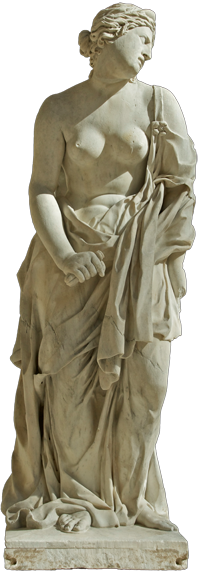Dido Queen of Carthage
Introduction

Statue: Dido attributed to Christophe Cochet (by 1634), now in the Louvre.
The Tragedy of Dido, Queen of Carthage is one of the two Marlowe plays that have received the least attention historically, both from a staging and a critical perspective. But whilst The Massacre at Paris is only extant in what is believed to be a 'reported text', Dido has no such excuses for being unjustly neglected.
That state of affairs has changed, however, in more recent years. As long ago as 1919, described the play as "underrated",1 and despite some generally accepted flaws in what is believed by many commentators to be Marlowe's first dramatic effort, perhaps written whilst still at Cambridge University, there is still much to admire in both the dramatisation and the poetry. More serious critical consideration seems to have encouraged in turn more frequent productions of the play, and after the remarkable staging of Dido in the State Apartments at Kensington Palace in 2008, major UK productions of the play have been produced by the National Theatre (2009) and the RSC (2017).
In many ways, Dido is one of Marlowe's most fascinating plays. Although far from being the straight translation of Aeneid that it was sometimes lazily dismissed as, the close ties between the play and its source does provide us with a rare glimpse of Marlowe at work. The scenes that the playwright has added, the changes in characterisation, even the elements that Marlowe has chosen to leave out, all give us some insight into his process of dramatisation, his ideas, and perhaps where his sympathies might lie.
The history of the play throws up some intriguing mysteries. The only contemporary printing of the play, the 1594 Quarto, tells us both that the play was performed by "the Children of her Majesties Chappell", and that the play was "written by Christopher Marlowe, and Thomas Nash. Gent". We have no record of any such performance by the royal children's company, who do not seem to have acted at court or in the private theatres between 1584 and the end of the century. So just when was the play written, and who was it written for?
And what is the extent of Nashe's input? Is this a joint authorship, or is Nashe's contribution simply the tantalising elegy allegedly written by him shortly after Marlowe's death and reported as inserted in some copies of the printed play? If such an elegy did exist, how frustrating that it is now lost, even if there are some small clues to some of its content.
This overview provides a brief summary of the plot and individual scene summaries, as well as pen pictures of the dramatis personae. Consideration is given to the various sources that Marlowe used, as well as providing some views on how Marlowe adapted them when writing his play. The questions raised above are addressed in sections covering the dating and authorship, as well as the textual and stage history of the play.
Some of the key themes in the play are picked out, along with a consideration of how it might have been staged and the different critical reactions to the play since it was first written. Could William Shakespeare really have been the first theatre critic to review Marlowe's play...?!
Publication Note: This overview of Marlowe's play of Dido, Queen of Carthage was written by and first published on the Marlowe Society (UK) website in 2009. That initial overview is here much updated by the same author, considering more recent criticism, research and productions, and published here on the Kit Marlowe 1564 website in 2025.
Footnotes:
- Note 1: , The Sacred Wood - Essays On Poetry And Criticism (Methuen London, 1920). In his essay, Some Notes on the Blank Verse of Christopher Marlowe, Eliot says "it is more desirable, in brief space, to remark upon two plays, one of which has been misunderstood and the other underrated. These are the Jew of Malta and Dido Queen of Carthage. ". Back to Text